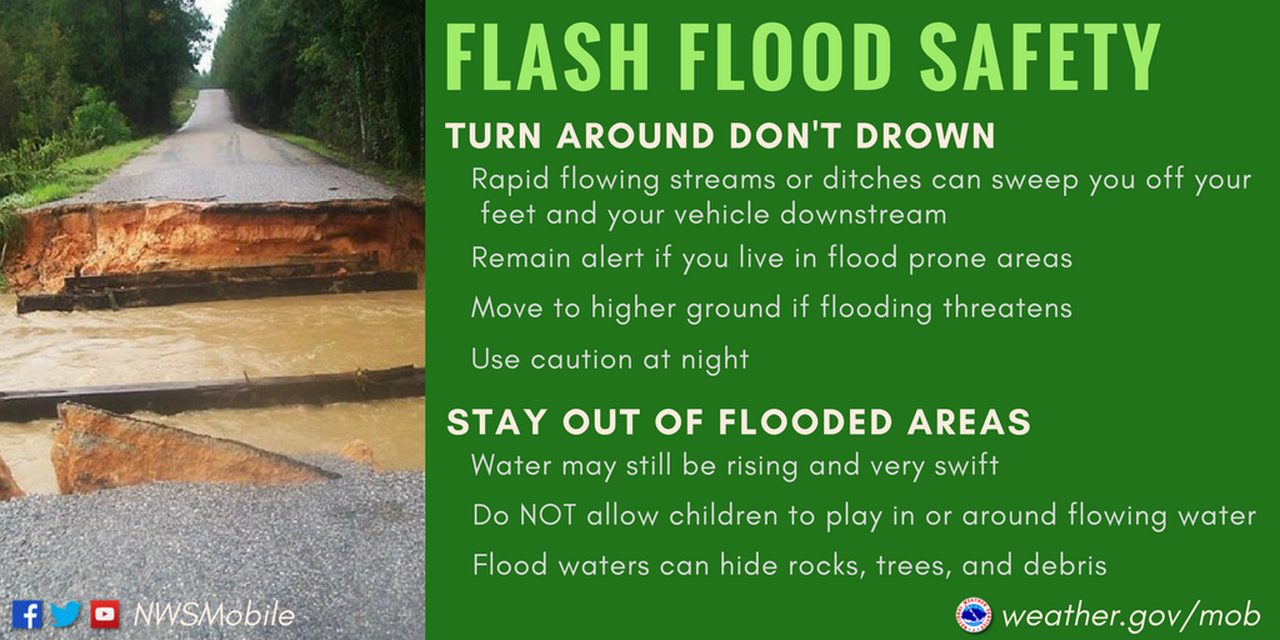Responding To A Flood Warning: Key Safety Tips From The National Weather Service

Table of Contents
Evacuate Immediately When Instructed
The most critical piece of advice regarding flood safety is this: obey evacuation orders immediately. Ignoring a flood warning issued by the National Weather Service can have deadly consequences. Rising floodwaters move quickly and powerfully, carrying debris that can inflict serious injury or death. Furthermore, electrical hazards are prevalent during floods, posing significant risks to anyone who remains in a flood-prone area.
- Know your evacuation route: Plan your escape route in advance, identifying multiple potential paths. Knowing where you're going is critical when time is of the essence.
- Have an emergency plan, including a meeting place: Designate a safe meeting location outside the flood zone where your family can reunite after evacuation.
- Take essential documents and valuables with you: Grab irreplaceable items like important papers, medications, and cherished photos before leaving.
- Never drive through flooded areas: Flooded roads are extremely dangerous. The depth of the water is often deceptive, and even a seemingly shallow stream can sweep away a vehicle. Turn around, don't drown.
Protecting Your Home Before a Flood
While evacuation is paramount, taking proactive steps to protect your home before a flood can significantly minimize damage. Flood preparedness begins well before a warning is issued.
- Elevate valuable items: Move important possessions, furniture, and appliances to higher floors or secure them off the ground.
- Move electrical appliances to upper floors: Protect electronics from water damage by moving them to higher levels. Unplug appliances to prevent electrical hazards.
- Turn off utilities (electricity, gas): Shutting off power and gas lines reduces the risk of electrical shocks and gas explosions.
- Bring outdoor furniture inside: Secure loose items that could be swept away and cause damage or injury.
- Consider flood insurance: Flood insurance is often not included in standard homeowner's insurance policies. Check with your insurance provider to see if you have adequate coverage.
Staying Safe During a Flood
During the flood event itself, staying informed and taking appropriate precautions is key. Monitor the situation closely, remaining vigilant to changing conditions.
- Monitor the situation through official sources (National Weather Service, local news): Rely on trusted sources for up-to-date information and warnings.
- Stay informed of changing conditions: Keep an eye on water levels and weather reports to understand the evolving situation.
- Avoid contact with floodwater: Floodwaters are often contaminated with sewage, chemicals, and other hazardous materials, posing serious health risks.
- If trapped, seek higher ground and call for help: If you become trapped by rising waters, find the highest safe ground available and call emergency services immediately.
After the Flood: Safety and Recovery
The danger doesn't end when the floodwaters recede. Post-flood safety and recovery require careful attention.
- Beware of downed power lines and structural damage: Damaged infrastructure poses significant hazards. Stay away from any damaged areas.
- Avoid floodwater; it may be contaminated: Floodwaters can remain hazardous long after the flood subsides. Avoid contact.
- Report damage to authorities: Contact local authorities to report damage to your property and infrastructure.
- Contact insurance providers: File insurance claims as soon as possible to begin the recovery process.
- Clean and disinfect affected areas thoroughly: Mold and mildew can grow quickly in damp areas, posing health risks. Thorough cleaning and disinfection are essential.
Resources for Flood Safety Information
Staying informed is crucial for flood safety. Here are some vital resources:
- National Weather Service website:
- FEMA website:
- Local emergency management agency: Contact your local government for specific flood safety information and resources.
Conclusion: Be Prepared for Flood Warnings – Protect Yourself and Your Family
Responding effectively to a flood warning requires preparedness, awareness, and swift action. By following these safety tips from the National Weather Service, you can significantly reduce the risks associated with flooding. Remember the key steps: evacuate when instructed, protect your home beforehand, stay safe during the flood, and take necessary precautions after the waters recede. Develop a family flood preparedness plan, sign up for National Weather Service alerts, and share this critical flood safety information with your community. Your preparedness is your best defense against the devastating power of floods.

Featured Posts
-
 Lewis Hamiltons Influence The F1 Rule Change Explained
May 26, 2025
Lewis Hamiltons Influence The F1 Rule Change Explained
May 26, 2025 -
 F1 Drivers Press Conference What The Drivers Said
May 26, 2025
F1 Drivers Press Conference What The Drivers Said
May 26, 2025 -
 Rekordnye 300 Podiumov Mercedes Rol Lyuisa Khemiltona I Dzhordzha Rassela
May 26, 2025
Rekordnye 300 Podiumov Mercedes Rol Lyuisa Khemiltona I Dzhordzha Rassela
May 26, 2025 -
 G7 Finance Ministers Ignore Looming Tariffs In Final Statement
May 26, 2025
G7 Finance Ministers Ignore Looming Tariffs In Final Statement
May 26, 2025 -
 Exploring The Hells Angels Origins Ideology And Global Presence
May 26, 2025
Exploring The Hells Angels Origins Ideology And Global Presence
May 26, 2025
Latest Posts
-
 Invergordon Welcomes Nieuw Statendam A Boost For Easter Ross Tourism
May 29, 2025
Invergordon Welcomes Nieuw Statendam A Boost For Easter Ross Tourism
May 29, 2025 -
 Fincantieri And Tui New Cruise Ships For Uk Market
May 29, 2025
Fincantieri And Tui New Cruise Ships For Uk Market
May 29, 2025 -
 Pop Icon Robbie Williams Performs At Cruise Ship Christening In Malaga
May 29, 2025
Pop Icon Robbie Williams Performs At Cruise Ship Christening In Malaga
May 29, 2025 -
 Robbie Williams Malaga Concert Cruise Ship Christening Spectacle
May 29, 2025
Robbie Williams Malaga Concert Cruise Ship Christening Spectacle
May 29, 2025 -
 Enhanced Partnership Starboard And Tui Cruises Announce Expanded Collaboration
May 29, 2025
Enhanced Partnership Starboard And Tui Cruises Announce Expanded Collaboration
May 29, 2025
